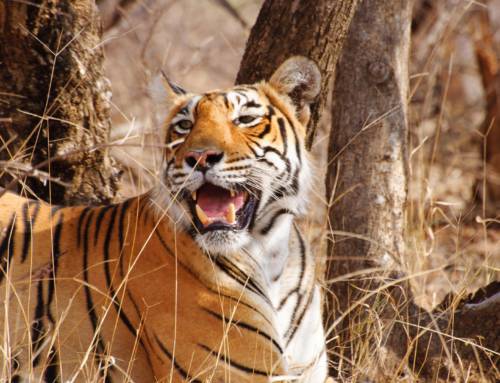Research article: Srivathsa, A., Puri, M., Karanth, K. K., Patel, I., & Kumar, N. S. (2019). Examining human-carnivore interactions using a socio-ecological framework: sympatric wild canids in India as a case study. Royal Society Open Science, 6(5), 182008. https://royalsocietypublishing.org/doi/10.1098/rsos.182008
Blog Author: Alby Wilson
Key Highlights:
- People who live in and around forests depend on them for various needs, like the collection of firewood, non-timber forest products, as well as grazing land for livestock.
- The study investigates the distribution of carnivores in human-use landscapes and the possibilities of livestock attacks in the Kanha-Pench forest landscape in Madhya Pradesh.
- This heterogeneous landscape of dry deciduous forest constitutes agricultural land, scrublands, and grasslands.
- The authors focus on five carnivore species of the dog family here: Indian grey wolf, dhole, Indian jackal, Indian fox, and the striped hyena.
- They conducted questionnaire-based interview surveys with residents to understand the human-carnivore interactions in this landscape.
- Results highlight that wolves, jackals, and foxes were more prevalent in scrublands, poultry holding areas, and near human settlements, making them high-conflict-risk species; whereas dholes and hyenas avoided areas with livestock movement, making them low-conflict-risk species.
Carnivores are often found in human-use settings around the world. The geographical overlap between humans and carnivores creates complicated situations. Carnivores sometimes predate on livestock, making conservation in human-use regions difficult. These situations are more frequent in developing nations where the current conservation measures concentrate on setting up and managing reserves. Can this lead to problematic shared space use between people and predators? And if so, which group is the most affected?
Keeping these questions in mind, researchers focused on five carnivore species of the dog family: the Indian grey wolf, dhole, jackal, hyena, and fox. The study was conducted in the Kanha-Pench forests as these landscapes, with over 400 villages, had higher chances of interacting with wildlife with humans. From October 2015 to January 2016, the team explored forest roads and trails for the presence of these species. They conducted questionnaire-based interview surveys with the residents here to know about livestock predation due to these carnivores. So let’s see what they found out!
The study findings highlighted various aspects of the distribution and attack patterns caused by these five species. The team covered 1631 km on foot and found the presence of 16 wolves, 4 dholes, 64 jackals, 23 foxes, and 9 hyenas in this landscape. The team identified 121 carnivore attack cases reported from different sites: 68 by wolves, 9 by dholes, and 44 by foxes. Dhole attacks on livestock were more in areas with forest cover and less in livestock areas near human habitations; wolves attacked livestock mostly in scrublands and goat-holding areas, and foxes attacked mainly in poultry-holding areas. The research team recorded free-ranging dogs in 68 out of 128 sites. The presence of so many free-ranging dogs in the area indicated interaction with a large number of wild carnivores, including wolves, jackals, foxes, and hyenas. These dogs can act as a reservoir for dangerous diseases that cause hidden risks to livestock, wild animals, and people’s health.
The study found that dhole and hyena are low-risk conflict species because they avoid areas with high livestock movements. In contrast, wolves, jackals, and foxes were high-risk conflict species as the depredation by these species was higher in scrublands, small settlements, and poultry/goat-holding areas. The study also highlights that scrublands are important for dhole, wolves, jackals, and hyenas for habitat connectivity in the landscape. Because of the perception of scrublands as wastelands, and jurisdiction issues, scrublands in India go unpreserved.
Further, the authors explored the effectiveness of measures used to prevent livestock attacks. In the study landscape, the villagers used basic fencing techniques, as well as livestock shelters, kept watchdogs, and lit fires during the night to avoid livestock depredation. The state government provides insurance schemes and compensation for livestock losses. These could help humans and their livelihoods. But what can we do for carnivore protection?
Authors recommend conservation efforts focused on retaining the current land-cover structure, geography, and diversity to conserve these carnivore species at the regional level. The projections of carnivore distribution and livestock depredation patterns can help prioritize conservation efforts. Systematically identifying areas to invest precious funds can help resolve conflict and control the free-ranging dog population, and benefit both humans and wild carnivores in the landscape.
Keywords: carnivores, human-use landscapes, depredation, livestock, Madhya Pradesh, Central India.
You can access the original article here.



